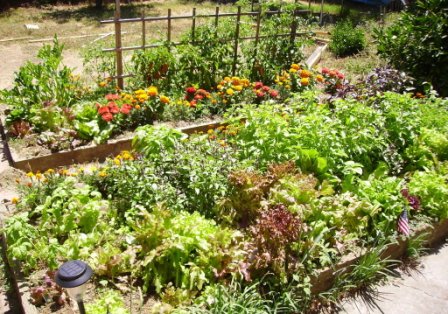
Did you know that Native Americans always planted the Three Sisters –beans, corn and squash – together in the same vegetable bed? The reason is pure genius: the corn stalks support the climbing beans and provide just the right amount of shade for the squash, which trails on the ground keeping it moist, suppressing weeds and warding off pests, while the beans make atmospheric nitrogen available to the corn and the squash. It’s a win-win-win situation.
Companion planting means planting different species close together so that they enhance each other’s growth. If, like many gardeners, you’re always on the lookout for useful tips and tricks to get the most out of your crops, here are 7 reasons to show you how companion planting can truly revolutionize your approach to vegetable growing.
Saves Space
Companion planting is a great idea for smaller gardens. You can save space by planting a vining plant under a taller plant to fill up the otherwise empty space that might be prone to weeds – just like in the corn and the squash in the example above. Or why not fill the gaps between slow growing crops with quick growing vegetables? Radishes are a useful companion to sow between rows of slower growing crops.
Keeps the Soil Moist
Preventing the soil from drying out is best achieved by covering up large areas of open soil. Squashes and cucumbers are particularly helpful for shading the soil and holding water. Don’t forget that larger plants can also provide welcome shade to seedlings and shade loving plants. Spinach and radishes, for instance, thrive well together.
Weed Control
Ground coverage is not only essential for keeping the soil moist, it’s also important for organic weed control. By planting pumpkins or other creepers in between runner beans or sugar snap peas, it will help the climbers to grow without having to compete with weeds for nutrients from the soil.
Deters Pests and Parasites
Pest control is easier with companion planting than it is with monoculture. Many fragrant herbs act as insect repellents and will protect their companions. Mint, for instance, deters ants and cabbage moth, while lavender repels ticks. Aphids and beetles hate marigold – a useful trick for planting with tomatoes and roses. Plant cauliflower with zinnias that attract ladybirds which in turn control cabbage flies.
Aids Pollination
Plants that attract bees and butterflies will bring in more pollinators, which in turn ensure a better crop yield. Beneficial insects will want to spend more time in your garden if there’s plenty of food available, so make sure you include patches of clover, buckwheat, vetch, bee balm, zinnia, yarrow or vetch in your vegetable garden.
Provides Physical Support
Climbing plants obviously need support, but rather than investing in trellises, frames or wigwams, there are many tall plants that can be cultivated to provide the same benefit. They include corn and sunflowers, Jerusalem artichokes, fruit and nut trees.
Improves Crop Yield and Flavor
This is where companion planting really comes into its own. The reason why some plant companions do so much better together instead of on their own is they have complementary nutritional requirements. Sweet marjoram, planted with beans, aubergines, cucumbers or pumpkin, helps to increase their yield. Radishes benefit from having nasturtiums planted nearby, while dill and tarragon help to improve the flavor and crop of cabbages.
Mike James is an independent writer that specializes in houseplants. He wrote this piece in conjunction with Totally Plants Indoor-Plants.co.uk.



Comment here